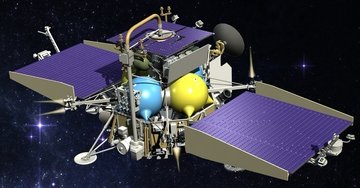The spacecraft got stuck in orbit around the Earth, apparently due to a malfunction in the boosters. The two flights that were supposed to raise it to a higher altitude and then on the way to Mars were not carried out

The glitches continue to haunt the Russian Mars project. The Phobos-Grunt spacecraft that was launched last night for a mission during which it was supposed to take a sample from the reddish moon Phobos got stuck in orbit around the Earth. Two ignitions, the first of which was supposed to raise it to a higher orbit and the second, an hour and a half later - to inject it into orbit towards Mars, were not carried out.
The original knowledge
After an absence of almost two decades, Russia is renewing its ambitious interplanetary plan. Tonight (Tuesday 22:16 Israel time - Wednesday 00:16 Moscow time). The Phobos-Grunt spacecraft is supposed to scrape rock and soil samples from the mysterious moon Phobos.
The Russian space program suffered years of cuts after the breakup of the Soviet Union and there were doubts as a result of previous failures in flights to Mars. The Russian leap comes just as the American leadership in space is fading and the NASA budget is being cut by the politicians in Washington.
Russia will make a dangerous landing on Phobos robot that will take samples. According to Alexei Kuznetsov, head of the press office of Roscosmos, in a conversation with the Universe Today website.
Phobos-Grunt is supposed to complete the journey to Mars and back in 34 months and return the capsule to Earth in August 2014, where Russian military helicopters will await its landing.
After 11 months of interplanetary travel, the spacecraft will enter orbit around Mars and spend several months searching for a suitable landing site on Phobos. The spacecraft is scheduled to gently land on the surface of Phobos in February 2013 using radar and precision engines adapted to Phobos' very weak gravity. After collecting the samples using two robotic arms, the soil will be transferred to a capsule that is supposed to return to Earth and which will take off in a return vehicle for the journey home.
see also: Phobos and Deimos - summary of findings

4 תגובות
Keep us updated, she does continue to Mars, what fun 🙂
The Russian unmanned spacecraft have always been less successful than the American ones.
The launch failed :(…
Too bad she probably won't get there anymore:
http://www.ynet.co.il/articles/0,7340,L-4145814,00.html
At least this time they had insurance for such a case and would be able to rebuild everything.